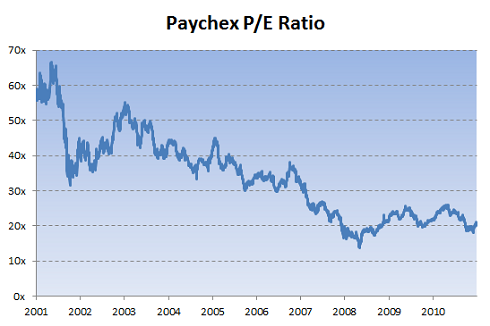The 3 Keys to Paychex's Returns
Despite constant attempts by analysts and the media to complicate the basics of investing, there are really only three ways a stock can create value for its shareholders:
Dividends.
Earnings growth.
Changes in valuation multiples.
In this series, we drill down on one company's returns to see how each of those three has played a role over the past decade. Step on up, Paychex (NAS: PAYX) .
Paychex shares returned 9.6% over the past decade. How'd they get there?
Dividends get most of the credit. Without dividends, shares actually lost 16.5% over the past ten years.
Earnings growth was surprisingly strong. Paychex's normalized earnings per share grew by an average of 8.4% a year from 2001 until today. That's impressive given the state of the economy and Paychex's link to the weak labor market, and is considerably stronger than earnings growth at larger rival ADP (NYS: ADP) .
But if earnings were so strong, why were returns so weak? This chart explains it:

Source: S&P Capital IQ.
Paychex's valuation multiple has dropped like a rock. Every bit of Paychex's earnings growth over the past decade has been buried by compressing earnings multiples, preventing shareholders from being rewarded. Of course, this was almost entirely due to the fact that shares were grossly overvalued ten years ago. At over 60 times earnings, shareholders in 2001 were guaranteeing themselves a miserable decade, and that's exactly what they got. This chart also answers the question of how long it can take for an overvalued stock to become cheap again: At least a decade.
Thankfully, I think that nightmare is near an end. Given the strength of Paychex's business, shares seem reasonably valued at current levels. Even if employment just hovers along, Paychex should provide shareholders a decent return, particularly given its strong dividend. If employment does bounce back, or if interest rates rise, which juices the company's income on money held for customers, Paychex could prove to be a phenomenal investment going forward.
Why is this stuff worth paying attention to? It's important to know not only how much a stock has returned, but where those returns came from. Sometimes earnings grow, but the market isn't willing to pay as much for those earnings. Sometimes earnings fall, but the market bids shares higher anyway. Sometimes both earnings and earnings multiples stay flat, but a company generates returns through dividends. Sometimes everything works together, and returns surge. Sometimes nothing works and they crash. All tell a different story about the state of a company. Not knowing why something happened can be just as dangerous as not knowing that something happened at all.
Add Paychex to My Watchlist.
At the time thisarticle was published Fool contributorMorgan Houselowns shares of Paychex. Follow him on Twitter @TMFHousel.Motley Fool newsletter serviceshave recommended buying shares of Automatic Data Processing and Paychex. Try any of our Foolish newsletter services free for 30 days. We Fools may not all hold the same opinions, but we all believe that considering a diverse range of insights makes us better investors. The Motley Fool has a disclosure policy.
Copyright © 1995 - 2011 The Motley Fool, LLC. All rights reserved. The Motley Fool has a disclosure policy.

